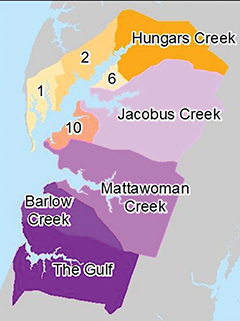By Linda Cicoira
Replacement, repairs, and pump outs for about 30 septic systems in Northampton County watersheds between Eastville and Birdsnest will be done with an $82,500 grant awarded this week to the Accomack-Northampton Planning District Commission (A-NPDC).
Officials said the work will reduce pollution in the Gulf, Barlow, Mattawoman, Jacobus, and Hungars creeks, where levels of bacteria exceed state water quality standards. The creeks drain into the lower Chesapeake Bay.
If not properly maintained, septic tanks can leak bacteria and nutrients into groundwater and leach into surrounding creeks and tributaries. All but the Barlow “do not support Virginia’s bacteria standards for the production of edible and marketable seafood,” according to a Virginia Department of Environmental Quality (DEQ) file.
The standards protect public health for swimming, fishing, and drinking water and safeguard aquaculture.
“The principal benefit to the oyster growers in these creeks would be that once the water quality is restored, they would no longer need to transport their floats to clean water to depurate oysters prior to consumption,” the file continued. “It is important to note that there are substantial aquaculture activities in Cherrystone Inlet, which is less than 6 miles south of the Gulf. All of these creeks already meet the state water quality standards for safe swimming. However, further reducing fecal contamination levels in these creeks, particularly from human sources will improve public health by reducing the risk of infection from fecal sources through contact with surface waters.”
“The residential programs will play an important role in improving water quality, but there may also be (an) additional return on the investment in terms of economic benefits to homeowners,” the file continued. “An improved understanding of private on-site sewage systems, including knowledge of what steps can be taken to keep them functioning properly and the need for regular maintenance, will give homeowners the tools needed for extending the life of their systems and reducing the overall cost of ownership. The replacement of failing on-site sewage disposal systems with new septic or alternative treatment systems will have a direct and substantial impact by improving property values and improving the local economy.”
The EPA requires states to develop a total maximum daily load (TMDL), or “pollution diet,” to identify pollution sources and contaminant levels that need to be reduced. DEQ completed a study in the area between 2007 and 2010 and identified excess amounts of fecal bacteria, mostly from humans, livestock, and pets. The funding was provided by DEQ through a grant from the EPA’s Clean Water Act Nonpoint Source Program.
“The grant is anticipated to complete the following, but with the understanding that these numbers are likely to change once we begin working with the community and more accurately assessing need,” Shannon Alexander, the ANPDC’s Coast Resources Program Manager, said Tuesday. Her list included 22 septic pump outs, four system repairs, two installation/replacement systems, an installation/replacement system with a pump, and installation of an alternative on-site system.
Matching funds are required from the homeowner, Alexander said. For those most in need, Southeast Rural Community Assistance Project Inc. will provide an additional $13,400 for the project.
“We are continually working with our local communities to identify best management practices that will reduce bacteria pollution in the area,” said Craig Nicol, director of the Tidewater DEQ office. “Fixing and restoring septic tanks is an important step towards achieving clean water and protecting shellfish along the Eastern Shore.”
The plan was approved by the EPA in 2015 and focused primarily on septic tank repairs, pet waste removal stations, and agriculture practices. The project is slated to begin later this year with completion in late 2020.
Estimates referenced in DEQ files for agricultural, residential, and educational programs total $1,877,650. A breakdown of the total shows $420,600 is needed for the Gulf, $136,800 for Barlow Creek, $373,450 for Mattawoman Creek, $390,850 for Jacobus Creek, $217,600 for Hungars Creek. Hungars was also separated into sub-watersheds with $198,550 needed for sub-watershed Number 1 for $60,700 for Number 2, $16,650 for Number 6, and $62,450 for Number 10.
Phase 2 implementation costs for all of the watersheds combined was estimated to be $332,700. An analysis shows The Gulf at $81,000; Barlow Creek at $23,100; Mattawoman Creek at $61,800; Jacobus Creek at $76,500; Hungars Creek at $22,200. The sub-watersheds’ costs were shown as $43,800 for Number 1, $7,200 for Number 2, $1,500 for Number 6, and $15,600 for Number 10.
“Although Barlow Creek was removed from the Impaired Waters List in 2012, it was included in this plan to address actions that can be used to prevent future unacceptable fecal coliform loading in the watershed,” according to the DEQ file. “The applicable fecal coliform bacteria standard specifies that the 90th percentile fecal coliform value for a sampling station not to exceed a most probable number (MPN) of 49 per 100 milliliters.”



